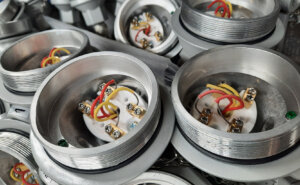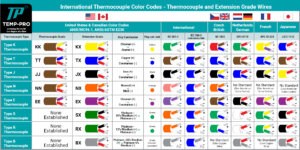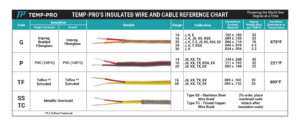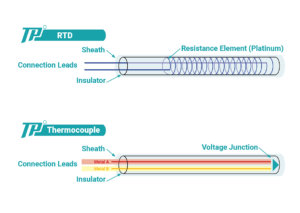Thermocouples are widely used temperature sensing devices, known for their versatility and durability. Explore the world of thermocouples!
 What Is a Thermocouple?
What Is a Thermocouple?
A thermocouple is a temperature sensor that consists of two different types of metals joined at one end. These metals are joined together at one end to form the measuring junction, while the other end, known as the reference junction, remains at a known temperature. They operate based on the Seebeck effect, which is fundamental in measuring temperature accurately in both industrial and scientific applications.
Thermocouple Types and Uses
Delving into the diverse array of thermocouples, we encounter classifications like base metal thermocouples (e.g., Types J, K, T, E) and noble metal thermocouples (e.g., Types R, S, B), each meticulously engineered for distinct measurement scenarios. This section highlights the specifications and operational domains of these types, including Type K thermocouples, known for their versatility in extremely high-temperature environments.

Thermocouple Types & Color Coding
Explore the intricacies of the thermocouple color coding system, a standardized methodology crucial for accurate identification and application across different thermocouple types. This color coding assigns specific colors to thermocouple types (e.g., Type K, J, T) and their corresponding connectors. This standardization is vital for accurate temperature measurement across various types of thermocouples.
Temperature Measurement with Thermocouples
Delve into the technicalities of temperature measurement using thermocouples, focusing on pivotal elements such as cold junction compensation and the function of extension wires. Learn more about the importance of these components in the precise and reliable functioning of thermocouples in various temperature-sensing applications.
Type K Thermocouples
Type K thermocouples, distinguished for their efficacy in extremely high temperature environments, are predominantly composed of nickel-alloy wires (Chromel and Alumel). Their widespread adoption across various industrial applications is attributed to their exceptional robustness and reliability. Their composition ensures stability and accuracy in temperature readings, even under the most demanding conditions, cementing their status as a preferred choice in high-temperature measurement technology.

Thermocouple Wire and Thermocouple Extension Wire
Recognize the criticality of choosing appropriate thermocouple and extension wires, crafted from materials such as copper nickel, for precise temperature measurement. The selection of these wires is pivotal in defining the thermocouple’s operational efficiency and response time. This consideration is especially vital in environments where rapid temperature fluctuations occur, as the response characteristics of the thermocouple are significantly affected by the material and quality of the wires used.
Causes For Thermocouple Measurement Errors
Identify common sources of errors in thermocouple measurements, notably mechanical damage and electromagnetic interference (EMI), to guarantee precise temperature readings, and learn how to mitigate these factors to ensure precise temperature readings. Additionally, routine inspections for physical damage and strategic placement away from potential EMI sources are essential practices to maintain the accuracy and reliability of thermocouple-based temperature measurement systems.
 RTDs Vs Thermocouples
RTDs Vs Thermocouples
Examine the distinct characteristics of RTDs (Resistance Temperature Detectors) and thermocouples, focusing on their differences in accuracy, response time, and temperature range suitability, which are pivotal in selecting the appropriate temperature sensor for specific applications. RTDs, known for their precise temperature measurements, operate by measuring the resistance changes in a metal (commonly platinum) with temperature variations. Thermocouples, on the other hand, generate a voltage at the junction of two dissimilar metals, responding swiftly to temperature changes. This comparison underscores the importance of considering the specific demands of a temperature measurement task – whether it prioritizes rapid response, extreme temperature endurance, or high precision – in choosing between RTDs and thermocouples.
In conclusion, thermocouples stand as a cornerstone in the field of temperature measurement, offering a blend of versatility, reliability, and precision that is hard to match. From the robust Type K thermocouples, excelling in high-temperature environments, to the intricacies of thermocouple color coding and the selection of appropriate extension wires, every aspect is crafted to ensure optimal performance.
While understanding the nuances between thermocouples and other temperature sensors like RTDs is crucial for specific applications, the enduring value of thermocouples in a wide range of industrial and scientific settings is undeniable. Whether you’re managing common measurement errors or selecting the perfect type for your needs, the world of thermocouples offers a fascinating exploration into the art and science of temperature measurement. Trust in their proven track record, and let thermocouples guide you towards more accurate and reliable temperature monitoring in your projects.



